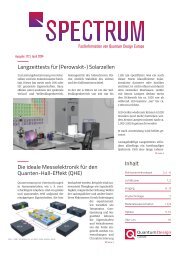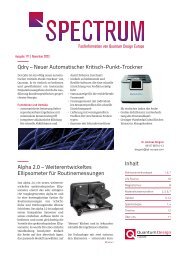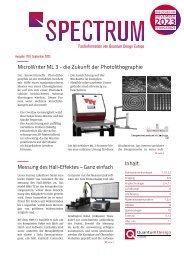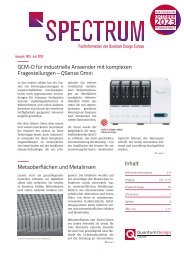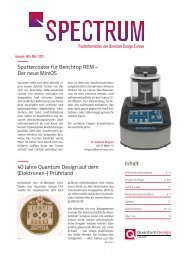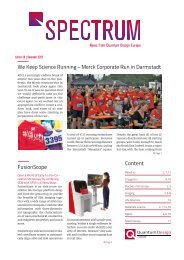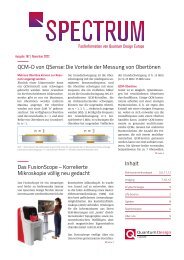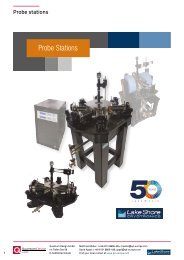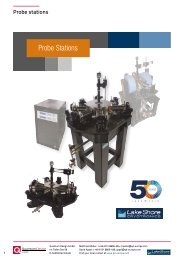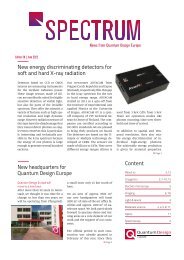Spectrum E40
Create successful ePaper yourself
Turn your PDF publications into a flip-book with our unique Google optimized e-Paper software.
WE ARE MOVING<br />
OCTOBER<br />
2023<br />
PFUNGSTADT<br />
News from Quantum Design Europe<br />
Edition 40 | July 2023<br />
QCM-D for Industrial Users Faced With Complex<br />
Challenges – QSense Omni<br />
In recent years, the use of quartz<br />
crystal microbalances in scientific<br />
research labs has increased<br />
tremendously. Thanks to better<br />
availability of suitable sensors, applications<br />
for polymers, biological<br />
systems, lipid bilayers, electrochemistry<br />
and many other areas have<br />
become possible.<br />
With QSense Omni, the new and<br />
enhanced instrument by the pioneers<br />
of QCM-D, this technology is<br />
now ready to support industrial<br />
users in solving the most complex<br />
problems. Omni is based on the<br />
proven QSense technology that has<br />
helped to develop a deeper understanding<br />
of molecular interactions<br />
at surfaces for decades.<br />
Of course, Omni<br />
offers frequency and<br />
dissipation measurement<br />
at seven-harmonics,<br />
as used from<br />
QSense systems.<br />
Omni combines the<br />
ability to increase<br />
the sensitivity of the<br />
QCM-D with clever<br />
automation of the<br />
measurement – from<br />
installation of the<br />
sensor to evaluation of the data.<br />
This allows measurements to be<br />
performed quickly and reliably<br />
and with little manual effort.<br />
Omni's sample feeder is designed<br />
in such a way that the sample<br />
containers are placed directly<br />
above the sensor. The distances<br />
Page 2<br />
Metasurfaces and Metalenses<br />
Lenses are widely used as a basic<br />
optical element in everyday life.<br />
They are used in cameras, eyeglasses,<br />
microscopes and many other<br />
devices. In this context, the lenses<br />
Beam shaping/collimation (Metalens)<br />
are developed on the basis of classical<br />
refractive optics, which leads<br />
to unavoidable imaging errors<br />
such as chromatic and spherical<br />
aberration and coma. To minimise<br />
these errors, conventional imaging<br />
systems usually use multiple lenses<br />
with different powers and different<br />
materials.<br />
Metasurfaces and metalenses offer<br />
high potential as substitutes for<br />
many classical optical components.<br />
They are a fundamentally new method<br />
of light manipulation that<br />
is based on scattering in nanostructures<br />
instead of conventional<br />
Page 3<br />
Content<br />
About us 2, 5, 11, 12<br />
Cryogenics 4, 6, 8, 11<br />
Electron microscopy 4, 5, 7, 9,10<br />
Imaging 3, 10<br />
Life Sciences 2<br />
Materials science 6, 7<br />
Optics 3, 9<br />
EUROPE
Life Sciences/About us<br />
QCM-D for Industrial Users Faced With Complex<br />
Challenges – QSense Omni<br />
to the sensor are very short, thus<br />
providing for well-defined changeover<br />
between samples. Cross-contamination<br />
or mixing between the<br />
individual measurement steps is<br />
largely eliminated.<br />
The hardware has been designed<br />
and optimised so as to provide a<br />
very low-noise signal (4x better than<br />
the QSense analyser) for a significantly<br />
improved detection limit.<br />
Thanks to the high degree of sensor<br />
handling automation, a reproducibility<br />
of the frequency value of ±2<br />
Hz can be achieved at installation,<br />
thus further improving the use of<br />
externally coated sensors.<br />
One consideration<br />
in developing<br />
Omni was<br />
to make sure<br />
that the system<br />
can be used with<br />
as many media<br />
(aqueous or organic)<br />
as possible<br />
to enable a<br />
broad range of<br />
applications.<br />
QSense Omni can be connected<br />
to the external platform QSense<br />
Orbit, that can be used with<br />
all known QSense combination<br />
modules (e.g. the QEM401 electrochemistry<br />
module, the QWM401<br />
window module or the QOM401<br />
open module) and also benefits<br />
from the improved<br />
Omni electronics<br />
and the autosampler.<br />
The QSense Omni<br />
measurement software<br />
controls the measurement<br />
and the autosampler. The measurement<br />
steps are defined by simple<br />
drag & drop handling. These<br />
steps may also be changed during<br />
the measurement and, as a matter<br />
of course, the script can be saved<br />
as a template.<br />
Finally, we would like to provide<br />
you with some interesting<br />
technical details:<br />
The temperature range is 4-70°C<br />
with a stability of
Optics/Imaging<br />
Metasurfaces and Metalenses<br />
refraction, thus allowing efficient<br />
phase, polarisation and emission<br />
control.<br />
They are able to precisely influence<br />
the wavefront of light, thereby producing<br />
impressive optical phenomena.<br />
Moreover, they are usually significantly<br />
smaller and less expensive<br />
than conventional solutions. With<br />
multidimensional metasurfaces, novel<br />
functions can be achieved that<br />
are difficult or impossible to achieve<br />
with conventional lenses.<br />
Our partner Moxtek has been producing<br />
nanostructured optical components<br />
for over 20 years, with highvolume<br />
manufacturing capabilities<br />
for the most different structures on<br />
Ø200mm wafers.<br />
The range offered includes the production<br />
of functional nanostructures<br />
such as microlens arrays, waveguides,<br />
patterned metasurfaces, diffractive<br />
optical elements (DOE), photonic crystals<br />
and biosensor arrays. These components<br />
for imaging, illumination<br />
and display systems are used for a variety<br />
of applications, including automotive,<br />
medical and dental imaging,<br />
camera systems and many others.<br />
Prototyping samples can be created<br />
based on our own in-house developed<br />
design master shuttle. This NIL<br />
(NanoImprint Lithography) design<br />
master shuttle provides space for<br />
multiple (different) design structures,<br />
allowing multiple designs to be tested<br />
in a single shuttle iteration. This<br />
dramatically reduces development<br />
time and cost. These design shuttles<br />
are created several times a year.<br />
We will be happy to discuss your<br />
metalens or optical nanostructure<br />
needs. Feel free to contact us any time<br />
Please contact us<br />
optics@qd-europe.com<br />
New NIR Camera from Xenics with High Sensitivity<br />
and Low Noise<br />
With its new InGaAs camera, Xenics,<br />
as a manufacturer of detectors and<br />
cameras, responds to the needs of<br />
our customers. Wildcat+ 640 features<br />
Xenics' in-house developed and produced<br />
640 x 512 pixel, 20 µm pixel<br />
pitch InGaAs sensor. This detector<br />
offers particularly high sensitivity<br />
with low noise, thus allowing for<br />
much shorter integration times or<br />
less extraneous light. Thanks to this<br />
detector with a readout noise of less<br />
than 45 electrons and a high fullwell,<br />
a high dynamic range of up to<br />
almost 70 dB is achieved. For camera<br />
control and data output, either a<br />
CameraLink may be used or a USB3<br />
vision interface. Wildcat+ 640 is compatible<br />
with GenICam, which provides<br />
for easy integration. The Wildcat+<br />
640 series offers a high frame<br />
rate. Full frame rates of 300 fps can<br />
be achieved. In the windowing mode,<br />
in which the number of pixels read<br />
out can be reduced, the camera even<br />
achieves readout rates of more than<br />
7000 frames per second.<br />
For versatile use in research, the<br />
Wildcat+ 640 operates in two readout<br />
modes: "integrate while read (IWR)"<br />
and "Integrate then read (ITR)". In addition,<br />
the camera is equipped with<br />
2 trigger inputs and 2 trigger outputs<br />
for optimised use in experiments or<br />
industrial processes.<br />
Please contact us<br />
imaging@qd-europe.com<br />
3 <strong>Spectrum</strong>, International edition 40 | July 2023
Electron microscopy/Cryogenics<br />
FusionScope project meeting<br />
In December Quantum Design US<br />
hosted a FusionScope project meeting<br />
at the QD headquarters in San<br />
Diego. Included were visitors from<br />
QD Germany and QD Microscopy,<br />
along with the sales, marketing, and<br />
R&D teams from San Diego.<br />
The first day was used to discuss the<br />
FusionScope launch that took place<br />
back in September including the<br />
first three conferences at which we<br />
exhibited the FusionScope.<br />
On the following days, the R&D<br />
lab and production site of the FusionScope<br />
were toured, which was<br />
a great opportunity for the QDM<br />
development team to experience<br />
first hand how their US counterpart<br />
operates.<br />
The tour was followed by an extensive<br />
discussion on next steps in<br />
terms of project development and<br />
upcoming technology milestones.<br />
We cannot wait to share these new<br />
FusionScope features with you in<br />
the next months.<br />
Please contact us<br />
em@qd-europe.com<br />
Cryogenic temperature measurement – sensor installation<br />
techniques for success<br />
Lakeshore Cryotronics is well<br />
known for their low-temperature<br />
measurement products,<br />
like the Cernox sensors and<br />
the model 336 temperature<br />
controllers. If you are new to<br />
this world or simply want to<br />
see our experts install a sensor<br />
in a cryogenic application,<br />
please follow the link below. It<br />
conleads to tains the recording of a<br />
webinar on the correct installation<br />
of a sensor in a cryogenic application<br />
and on how to avoid common<br />
installation errors, all presented by<br />
Lakeshore scientist Scott Courts.<br />
The Webinar topics include:<br />
■ Considerations for choosing a<br />
sensor (including resistance to<br />
magnetic fields, ionizing radiation,<br />
UHV, and others)<br />
■ The role of packaging and<br />
adapters for shielding, mounting,<br />
stability, and optimal thermal<br />
contact<br />
■ Considerations for sensor<br />
installation (placement, mounting<br />
method, materials, electrical<br />
connections, heat sinking,<br />
thermal contact medium, etc.)<br />
■ A look at the choices for fastening<br />
materials, wire leads,<br />
thermal mediums and adhesives<br />
The webinar can be found at the following<br />
link: bit.ly/3wWRE1V<br />
If you have a special application<br />
and would like support in selecting<br />
the right sensor, please do not hesitate<br />
to get in touch with us.<br />
Please contact us<br />
cryo@qd-europe.com<br />
4
Electron microscopy/About us<br />
DENSsolutions celebrate their 10th anniversary<br />
There is no need to introduce supplier<br />
of high-end in situ TEM systems<br />
DENSsolutions electron microscopists<br />
around the world. In<br />
the market of MEMS-based, ultrastable<br />
in situ TEM systems, they are<br />
one of the few big players. For years,<br />
they have been awarded regularly<br />
for their high quality products and<br />
innovations, the last award being<br />
the MSA Microscopy Today Innovation<br />
Award 2021. We are the proud<br />
sales and support partner for Germany,<br />
Austria, Switzerland, UK and<br />
Italy and are send a heartfelt<br />
Happy Anniversary.<br />
Well-known for their innovative<br />
spirit, DENSsolutions<br />
not only threw<br />
parties in their home<br />
regions Delft and Rotterdam,<br />
but also invented a<br />
unique drink: A handmade<br />
gin made from 10 selected ingredients<br />
forms the basis, which is<br />
mixed with tonic water, ice and a<br />
thin slice of cucumber to finally<br />
become<br />
The GIN Situ!<br />
The image of an atomically resolved<br />
gold nanoparticle at 1000 °C<br />
adorns the bottle label. This image<br />
is one of the first to have been taken<br />
with the DENSsolution in situ<br />
sample holder Wildfire about 10 years<br />
ago. It gives a great impression<br />
of the ultra stable performance of<br />
their systems. The positions of the<br />
gold atoms on the label have been<br />
overcoated with gold foil so that<br />
the microscopic world becomes<br />
macroscopically tangible. A dignified<br />
gift – We say thank you!<br />
Please contact us<br />
em@qd-europe.com<br />
May I introduce myself?<br />
My name is Miriam Wendel. I<br />
have been part of the accounting<br />
team at Quantum Design<br />
since November 2020. Previously,<br />
after training as a hotel manageress,<br />
I worked for many years as a receptionist<br />
for various large hotel<br />
chains and, after parental leave with<br />
my twins, spent some time in the order<br />
processing department of a measuring<br />
equipment manufacturer.<br />
After work, I like to spend my time at<br />
the riding stable, where I have had a<br />
riding partner for several years. Otherwise,<br />
I enjoy relaxing with yoga,<br />
reading a book in the garden, or<br />
being out and about with the family.<br />
At the beginning of the year, I successfully<br />
completed my part-time<br />
further education to become a certified<br />
financial accountant. In addition<br />
to the day-to-day business<br />
of Quantum Design, which we take<br />
care of as a team, I am also responsible<br />
for the accounting of Quantum<br />
Design Microscopy. I also handle<br />
the intercompany reconciliation<br />
between<br />
the European subsidiaries<br />
and our parent<br />
in the US and process<br />
travel expenses.<br />
I am happy to be a part<br />
of this great team and look forward<br />
to what the future will bring.<br />
Please contact us<br />
spectrum@qd-europe.com<br />
5 <strong>Spectrum</strong>, International edition 40 | July 2023
Materials science/Cryogenics<br />
Counting down to 2 Kelvin – the clock is ticking...<br />
This article depicts the fastest way to<br />
reach a sample temperature of 2 K<br />
or -271°C with the Quantum Design<br />
DynaCool. We start at 302 K, which is<br />
about normal ambient temperature.<br />
The DynaCool, or, more precisely, the<br />
PPMS-DynaCool, is a system for measuring<br />
physical properties at high<br />
magnetic fields and low temperatures.<br />
Depending on the available options,<br />
measured parameters can be<br />
magnetic, electric or thermal behavior.<br />
The system is operated by a sequence<br />
in the professional Windows<br />
software, where the user can manually<br />
determine the order of the executable<br />
commands. Coding knowledge<br />
is not necessary. The sequence<br />
is shown in the figure.<br />
This is how we proceed: We start a<br />
logfile for the data that interests us<br />
and, above all, the temperature and<br />
temperature status. After that, Dyna-<br />
Cool starts controlling the temperature.<br />
The maximum possible value<br />
is 50 K/min, which we do not fully<br />
achieve. Our highest speed is around<br />
30 K/min. After approx. 29 minutes,<br />
we fall below a sample temperature<br />
of 10 K, which means we have operated<br />
at an average speed of about<br />
10 Kelvin per minute. Once the temperature<br />
drops below 10 K, the DynaCool<br />
temp control automatically<br />
switches the cooling mode to the<br />
so-called “Low Temperature Flow”.<br />
The system’s cooling is now slower,<br />
but cooler. To achieve this, the system<br />
software changes the flow rate<br />
or the two capillaries which are the<br />
core of the temperature control. Below<br />
10 Kelvin, the base temperature<br />
of 1.85 K must be reached and stabilized.<br />
The system can remain at 1.85 K<br />
for an unlimited period of time.<br />
With 2 Kelvin, our goal is a bit higher.<br />
All in all, it hasn’t even taken 45 minutes<br />
to reach 2 Kelvin. The temperature<br />
stabilizes quickly. No variations,<br />
no oscillations and the noise stays in<br />
the mili-Kelvin range. The full temperature<br />
curve is depicted in the figure.<br />
The temperature is plotted on a<br />
logarithmic scale.<br />
According to our sequence, DynaCool<br />
stays at 2 Kelvin for 5 minutes and<br />
then heats up to 300 Kelvin again.<br />
Please contact us<br />
materials@qd-europe.com<br />
Model 372 – Resistance Bridge and Temperature Controller<br />
The video link below give a detailed<br />
insight into the Lakeshore resistance<br />
bridge and temperature<br />
controller model 372. In the video,<br />
Senior Product Manager Ryan Oliver<br />
discusses the features and functionality<br />
of the instrument, including<br />
the Model 372's powerful impedance<br />
measurement capabilities such<br />
as quadrature measurements and<br />
its patented noise-rejection<br />
technology.<br />
The ability to increase<br />
the num-<br />
ber of ment<br />
measure-<br />
channels<br />
to a maximum of 16 with the optional<br />
3726 scanner is also highlighted.<br />
http://bit.ly/3X9WrYA<br />
Please contact us<br />
cryo@qd-europe.com<br />
6
Materials science/Electron microscopy<br />
Dynamic Mechanical Compliance Testing (DMCT) for depth profiling<br />
and viscoelastic properties<br />
MicroMaterials have developed<br />
a new loading head for dynamic<br />
compliance testing. This new module<br />
allows measurements of depth<br />
profiles and viscoelastic properties.<br />
In conventional indentation, the<br />
load on the indenter is increased<br />
continuously to a maximum value<br />
before being reduced to produce an<br />
unloading Depth vs. Load curve. A<br />
single value of contact stiffness can<br />
be derived from this curve.<br />
Standard load head on the left, DMCT load head on<br />
the right<br />
In DMCT, a sinusoidal signal is<br />
superimposed on the load ramp<br />
such that, in effect, multiple nano<br />
unloading steps may be observed<br />
during the loading phase. The final<br />
unloading curve is not utilized<br />
for this measurement. The behavior<br />
of the oscillating indenter is<br />
described by a forced harmonic<br />
motion model. A calibration procedure<br />
characterizes the system<br />
properties: damping, spring stiffness,<br />
and mass of the loading<br />
head. These system characteristics,<br />
together with measured values of<br />
oscillation amplitude for a given<br />
oscillatory force or displacement<br />
allow the determination of contact<br />
stiffness<br />
By monitoring the phase difference<br />
between the applied oscillatory<br />
force and the resulting indenter<br />
displacement, it is also possible to<br />
measure the storage and loss moduli<br />
of polymers. In the DMCT module,<br />
Micro Materials have developed<br />
an improved approach using<br />
an additional 0-500 mN loading<br />
head with software and hardware<br />
features enabling a greater control<br />
of oscillation parameters which<br />
produce more reliable data.<br />
The DMCT module can be used for:<br />
■ Depth profiling of the mechanical<br />
properties like hardness,<br />
elastic modulus, H/E, contact<br />
stiffness.<br />
■ Viscoelastic property measurements<br />
(storage modulus, loss<br />
modulus, tan delta) at chosen<br />
frequencies and test temperatures.<br />
Important new developments<br />
include:<br />
■ A novel procedure (patent<br />
pending) for optimizing indenter<br />
oscillation control at low loads.<br />
■ An option for non-constant<br />
oscillation amplitude, where the<br />
oscillation force varies with load<br />
to achieve a fixed oscillation<br />
depth and therefore elastic<br />
modulus measurements on<br />
metallic materials.<br />
■ A new head design with the<br />
option of variable damping<br />
for optimized polymer analysis.<br />
The new loading head is<br />
again horizontal and maintains<br />
a significant advantage<br />
for high temperature testing.<br />
Click here http://bit.ly/3YKsgZw for<br />
3 case studies on the various options<br />
enabled by the DMCT-module:<br />
metallic materials, thin films, and<br />
viscoelastic nanocomposites .<br />
Please contact us<br />
materials@qd-europe.com<br />
Quantum Design‘s FusionScope at Conferences and Trade<br />
Shows Worldwide<br />
In September 2022, Quantum Design's<br />
latest product FusionScope was presented<br />
to the public at the Micros and<br />
Nano Engineering (MNE) Eurosensors<br />
in Leuven.<br />
FusionScope is an easy-to-use correlative<br />
microscope designed from the ground<br />
up to combine the benefits of SEM imaging<br />
with a wide range of AFM measurement<br />
techniques. MNE is one of the largest<br />
international conferences on micro<br />
and nano fabrication and applications.<br />
The FusionScope was met with<br />
great interest and we discussed<br />
with many interested scientists<br />
how it can benefit their research.<br />
Following that, visitors of the MS&T<br />
conference in Pittsburgh, the MRS<br />
conference in Boston and the Advanced<br />
Materials Show in Birmingham<br />
had the opportunity to experience for<br />
themselves the unique capabilities of<br />
our FusionScope.<br />
See you next time<br />
Please contact us<br />
em@qd-europe.com<br />
7 <strong>Spectrum</strong>, International edition 40 | July 2023
Cryogenics<br />
Janis cryostats<br />
More than two years ago, Janis Research<br />
has become part of Lake Shore.<br />
Since then, Lake Shore Cryotronics<br />
has merged the portfolios to offer<br />
comprehensive cryostat solutions<br />
for a broad range of applications.<br />
One major development has been<br />
the integration of calibrated temperature<br />
sensors in the cryostats<br />
so that they now feature the tages of calibrated silicon<br />
advandiodes<br />
and Cernox sensors<br />
as standard. Lake Shore<br />
temperature controllers<br />
thus offer perfect temperature<br />
control.<br />
The Lake Shore cryostat<br />
portfolio comprises a range<br />
of types from simple liquid<br />
nitrogen models like the<br />
VPF-100 for temperatures<br />
from 70 to 500 Kelvin to<br />
superconducting magnetic<br />
systems like the DryMag<br />
with a magnetic field of up<br />
to 12 T and sample temperatures<br />
of 1.5 - 700 K. The larger<br />
measurement platforms<br />
with magnet also use Lake<br />
Shore’s proprietary MeasureLINK<br />
software. This way,<br />
measurement routines can<br />
be created for each user in<br />
a tree structure, using dragand-drop<br />
or scripting.<br />
Cryostats are available for<br />
a wide variety of applications.<br />
To select the right system,<br />
it is good to answer a<br />
few questions up front:<br />
■ What type of cooling do<br />
you want to use: An open<br />
system, cooled with<br />
liquid helium or<br />
nitrogen? A closed cycle?<br />
■ Which temperature interval is to<br />
be covered by the cryostat?<br />
■ Which vibration level is necessary?<br />
■ Which atmosphere will the sample<br />
be in - vacuum or replacement<br />
gas?<br />
■ How fast do samples need to be<br />
exchanged?<br />
■ Is a compact design required? For<br />
example for microscopic applications?<br />
■ Will the cryostat be placed in a<br />
magnet?<br />
■ Are electrical feedthroughs<br />
or cables needed?<br />
Check out our website for an overview<br />
of our standard cryostats:<br />
www.qd-europe.com.<br />
If you cannot find the right cryostat<br />
for your particular application, please<br />
contact us! Together with Janis, we<br />
will build a customized solution.<br />
Please contact us<br />
cryo@qd-europe.com<br />
Measurement advantages<br />
Typical measurements<br />
Simultaneous source and measurement<br />
Synchronous source and measurement<br />
Low noise in source and measurement<br />
Dual AC/DC source<br />
Lock-In Autoranging<br />
Differential conductivity, low frequencies<br />
Differential conductivity, high frequency<br />
Resistance, low temperature<br />
I-V Characteristics<br />
Thermal conductivity<br />
Thermal transport<br />
Materials Research<br />
1D materials, thermoelastic<br />
materials<br />
Nano devices, superconducting<br />
devices, non-linear devices<br />
x x x x<br />
x x x x x<br />
Material development Linear systems, sensors x x x<br />
8
Electron microscopy/Optics<br />
New Publication by AFSEM user Wood K Plus<br />
The Austrian Kompetenzzentrum<br />
Holz GmbH is one of the leading<br />
research institutes in the area of<br />
wood and wood-related renewable<br />
resources in Europe. Its research covers<br />
a wide range of fields from the<br />
development of high-performance<br />
materials made from wood fibers<br />
and natural fibers to process technology<br />
along the complete value chain<br />
– from raw material to ”green composites“<br />
to finished products. This<br />
requires top expertise comprising<br />
especially the microscopic and macroscopic<br />
characterization of wood<br />
and fiber structures as well as latest<br />
technologies for stability investigations<br />
at macro-, micro- and nanoscale.<br />
These scientific challenges<br />
were the reason for Wood K<br />
plus to add AFSEM, the in-situ<br />
correlative AFM by Quantum<br />
Design to their research lab.<br />
There AFSEM is combined with<br />
a Keyence VHX 5000 optical microscope.<br />
The complementary<br />
strengths of both instruments<br />
support the research team in<br />
gaining completely new insights<br />
to their current scientific<br />
work.<br />
Following the installation,<br />
Wood K plus focused on AFSEM<br />
characterization of self-healing<br />
surfaces based on melamine<br />
resins. Thanks to the high<br />
resolution of the optical microscope,<br />
it was easy to position the cantilever<br />
tip precisely at the area of interest.<br />
The AFM was the method of choice to<br />
show melamine particles embedded<br />
in the polymer that is not visible in<br />
the topography. The phase signal AF-<br />
SEM provides was used for detection<br />
of material contrast (see figure 1).<br />
The light regions can be interpreted<br />
as hard material like melamine particles<br />
embedded in ‘soft’ polymer.<br />
Most recently, the research team of<br />
Wood K Plus used their AFSEM system<br />
to observe quality metrics such<br />
as surface stain and scuff resistance<br />
at the cross-section of wood-based<br />
materials. The obtained AFM data<br />
supported them in the further development<br />
of sample preparation<br />
techniques to better analyze the chemical<br />
and physical characteristics.<br />
They published their research results<br />
in an article in the Journal of<br />
Microscopy, Volume 289, Issue 2, February<br />
2023.<br />
Please contact us<br />
em@qd-europe.com<br />
Web Portal for Inquiries for Andover Bandpass Filters<br />
Andover offers a wide range of standard<br />
bandpass filters. To make it easier<br />
for you to select the right filter,<br />
we have set up a web portal. Here,<br />
you can see all filters in a clear layout.<br />
To automatically narrow the<br />
selection of filters shown, users can<br />
choose the specifications they are<br />
looking for. In the detailed view, you<br />
can see all specifications at a glance,<br />
together with the individual filter<br />
curves.<br />
Thus, you can find the right<br />
filter with just a few clicks.<br />
Our automatic inquiry system<br />
will immediately forward<br />
your selection to the<br />
corresponding staff. We will<br />
then contact you and give<br />
you a quote.<br />
Please contact us<br />
optics@qd-europe.com<br />
9 <strong>Spectrum</strong>, International edition 40 | July 2023
Imaging/Electron microscopy<br />
Andor Launches New Version of its Popular Zyla sCMOS Camera<br />
With ZL41 Wave sCMOS, Andor Technology<br />
presents the successor to its<br />
popular Zyla sCMOS camera. The<br />
latest model of the small sCMOS cameras<br />
from Belfast is more robust<br />
and powerful than ever before. Particular<br />
attention has been paid to a<br />
new design of the sensor chamber,<br />
which provides for longer service<br />
life with minimal service requirements.<br />
With a quantum efficiency of up to<br />
82% and a readout noise of
Cryogenics/About us<br />
Thanks to Sample Space, OptiCool Can Be Expanded<br />
to Feature a High Magnetic Field Sample Station<br />
When it comes to experiments requiring<br />
low temperatures, high magnetic<br />
fields and low vibrations, the<br />
range of cryostats that can be used is<br />
not exactly huge. If, moreover, a large<br />
sample area is required, the only<br />
available choice is OptiCool.<br />
OptiCool is a powerful optical cryostat<br />
that can be directly mounted on<br />
an optical table. Instead of the usual<br />
superconducting solenoid, it features<br />
a 7 Tesla split-coil magnet. This<br />
allows optical access both through<br />
a top window and several side windows<br />
and provides for a generous,<br />
free sample space with a diameter of<br />
89 mm.<br />
Common cryogenic sample stations<br />
offer a field strength of just up to<br />
3 Tesla and limited optical access.<br />
The OptiCool sample space is large<br />
enough to accommodate four XYZ<br />
positioning systems and a stationary<br />
sample holder. Thus, it can easily<br />
be expanded to provide an automated<br />
sample station with 7 Tesla field<br />
strength. The low vibration level of<br />
only 10 nm (peak-to-peak) ensures<br />
that the measurement tips do not<br />
lose contact with the sample. The<br />
contact pressure of a commercially<br />
available cryogenic positioner is significantly<br />
lower than that of a manual<br />
arm as used in cryogenic sample<br />
stations.<br />
Usually, the measuring tips of a sample<br />
station are cooled, but are still<br />
warmer than the sample. This causes<br />
the sample to be heated by the tips<br />
during measurement. In the Opti-<br />
Cool, the positioners and thus the<br />
measuring tips have the same temperature<br />
as the sample holder.<br />
Usually, the camera of a sample station<br />
can only show the position of<br />
the measuring tips. In the OptiCool,<br />
the working distance to the sample<br />
is significantly shorter than in solenoid<br />
magnets, so that a lens with<br />
a short working distance and high<br />
NA can be installed. Thus, combined<br />
optical and electrical measurements<br />
may be performed in addition to optical<br />
excitation. A corresponding setup<br />
was recently installed at Fraunhofer<br />
IPMS in Dresden.<br />
Please contact us<br />
cryo@qd-europe.com<br />
Merck company run 2023 – we were there again<br />
strengthen ourselves with food and<br />
drink at the Merck Stadium and were<br />
able to round off the successful day.<br />
This year we participated again as<br />
a team in the Merck company run.<br />
After 4500 participants were at the<br />
start last year due to corona, this year<br />
5798 runners crossed the finish line<br />
after a distance of between approx. 3<br />
and 10 km. Due to the higher number<br />
of participants and the partly<br />
very narrow course around the Böllenfalltor<br />
in Darmstadt, the pace<br />
was slow at the beginning and there<br />
were also some small traffic jams<br />
along the course. Of course, this did<br />
not stop us from being motivated to<br />
keep going. We all made it to the finish<br />
line and are proud to have been<br />
there again. After the run, we could<br />
As always, it was fun to accomplish<br />
something as a team.<br />
Please contact us<br />
spectrum@qd-europe.com<br />
11 <strong>Spectrum</strong>, International edition 40 | July 2023
About us<br />
European Headquarters<br />
Quantum Design GmbH<br />
Im Tiefen See 58, 64293 Darmstadt, Germany<br />
Phone +49 6151 8806-0, Fax +49 6151 8806 920<br />
E-mail spectrum@qd-europe.com<br />
www.qd-europe.com<br />
Quantum Design BeNeLux<br />
Meerstraat 177<br />
B-1850 Grimbergen, Belgium<br />
Phone +32 2 3084324<br />
Mobile +32 495797175<br />
E-mail struyve@qd-europe.com<br />
Quantum Design Czech Rep. and Slovak. Rep.<br />
Krivoklatska 37, 199 00 Praha 9, Czech. Rep.<br />
Phone +420 607 014 278, Fax +420 24 1046850<br />
E-mail czechia@qd-europe.com<br />
Quantum Design France SARL<br />
Bâtiment Mac Kinley, 1, avenue de l’Atlantique,<br />
91940 Les Ulis, France<br />
Phone +33 1 69194949, Fax +33 1 69194930<br />
E-mail france@qd-europe.com<br />
Quantum Design Iberia<br />
(for Portugal and Spain)<br />
Roca i Roca, 45, 08226 Terrassa (Barcelona), Spain<br />
Phone and Fax +34 937349168<br />
E-mail boira@qd-europe.com<br />
Quantum Design s.r.l., Italia<br />
Via Francesco Sapori, 27<br />
00143 Roma, Italy<br />
Phone +39 06 5004204, Fax +39 06 5010389<br />
E-mail italy@qd-europe.com<br />
Quantum Design Magyarország<br />
Primet Méréstechnikai Kft<br />
Eszak u. 24, HU-1038 Budapest<br />
Phone and Fax +36 1 2402711,<br />
E-mail steinbach@qd-europe.com<br />
Quantum Design Nordic<br />
(for Denmark, Finland, Norway and Sweden)<br />
Roddarestigen 3, 182 35 Danderyd, Sweden<br />
Phone +46 8 41071791<br />
E-mail eriksson@qd-europe.com<br />
Quantum Design Przedstawicielstwo Polska<br />
Mikoów: tel.:+48 32 24457<br />
Fax: +48 32 4281169, kom.: +48 50 255112014<br />
pdluzewski@qd-europe.com lub<br />
Chorzów: tel.: +48 32 2482048<br />
Fax: +48 32 70 21 160, kom.: +48 51 5166893<br />
E-mail kowalczyk@qd-europe.com<br />
Quantum Design SRL<br />
(for Romania and Bulgaria)<br />
Str Ion Nistor Nr 4, et 1, M2E<br />
030041 Bucharest, Ro.<br />
Phone +40 75 50 39 900, Fax +40 31 7107156<br />
E-mail buiu@qd-europe.com<br />
Quantum Design AG Suisse<br />
Route du Roule 41, 1723 Marly, Switzerland<br />
Phone +41 21 8699033, Fax +41 21 8699308<br />
E-mail reinicke@qd-europe.com<br />
Quantum Design Turkey<br />
Phone: +90 544 741 99 97<br />
E-mail turkiye@qd-europe.com<br />
Quantum Design Ltd. UK and Ireland<br />
1 Mole Business Park, KT22 7BA Leatherhead,<br />
Surrey, United Kingdom<br />
Phone +44 13 72378822, Fax +44 13 72375353<br />
E-mail info@qd-uki.co.uk<br />
Quantum Design Russia<br />
(for Russia and Central Eurasia)<br />
Phone +7 495 938-1866 , Fax +7 495 938-1907<br />
E-mail academ@qd-europe.com<br />
Team building and more<br />
In May, our company trip took<br />
place at the beautiful Seehotel in<br />
Niedernberg. The trip offered a<br />
packed two-day program that provided<br />
a diverse experience for all<br />
participants. On the first day after<br />
our arrival, we attended seminars<br />
on "Efficient Stress Management"<br />
and "International Project Work".<br />
Both seminars offered the opportunity<br />
for optimization and selfreflection,<br />
which was very valuable<br />
for our professional growth.<br />
After the seminars, we were able<br />
to end the day with a cozy dinner,<br />
where we could relax and share<br />
our impressions of the day. The<br />
dinner also gave us the opportunity<br />
to exchange ideas with colleagues<br />
and make new contacts.<br />
On the second day, the focus was<br />
on team building. Small teams<br />
were given the challenge of solving<br />
puzzles in a so-called "black box".<br />
This not only promoted team spirit,<br />
but also the creative problemsolving<br />
ability of each individual.<br />
After successfully completing the<br />
tasks, we headed to the marketplace<br />
in Großostheim, from where we<br />
took a hike to the Höflich winery.<br />
During the hike, we were entertained<br />
by Mr. Hartmut Hasenkopf<br />
with interesting stories about the<br />
area. This not only offered us a<br />
pleasant change of pace, but also<br />
created a relaxed atmosphere in<br />
which we could exchange ideas<br />
with our colleagues. In addition, we<br />
were treated to light snacks and refreshments<br />
to keep our energies up.<br />
As a crowning finale, we were invited<br />
to a final dinner at the Höflich<br />
winery. This evening gave us the opportunity<br />
to review the experiences<br />
and memories of our company trip.<br />
It was a great time that we greatly<br />
appreciate and are grateful for. The<br />
company trip allowed us to develop<br />
personally and professionally,<br />
strengthen team spirit and build<br />
valuable relationships with our<br />
colleagues.<br />
Please contact us<br />
spectrum@qd-europe.com<br />
Follow us on LinkedIn:<br />
https://www.linkedin.com/<br />
company/quantum-design-europe<br />
Editor: Joachim Weiss, PhD<br />
Please note that not all products are available in every country.<br />
12




